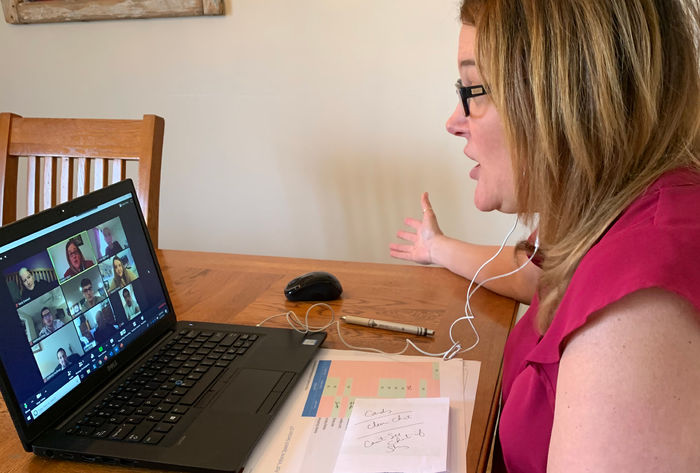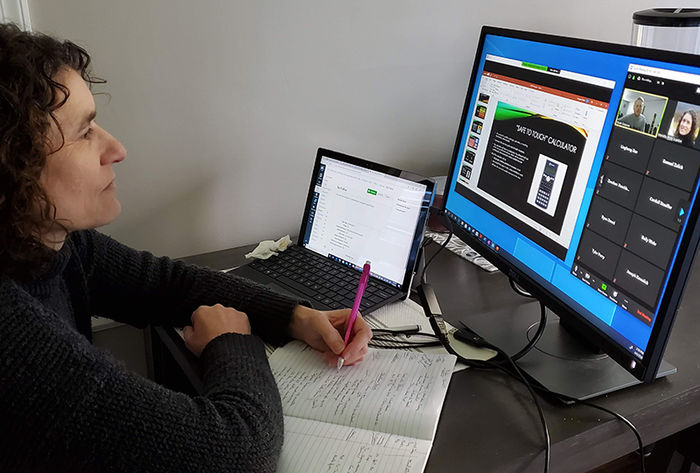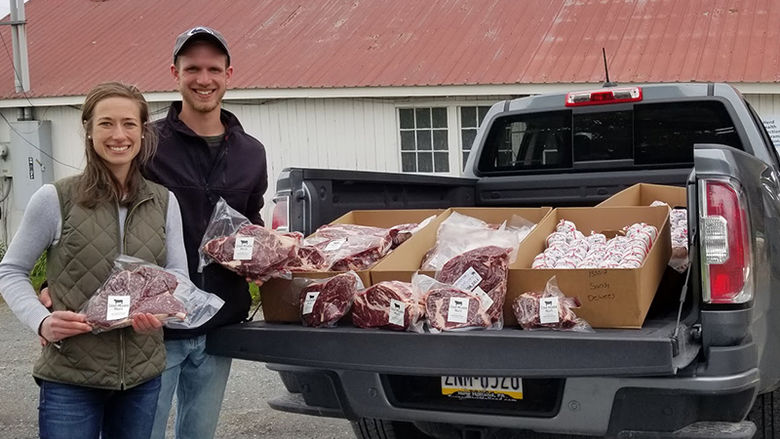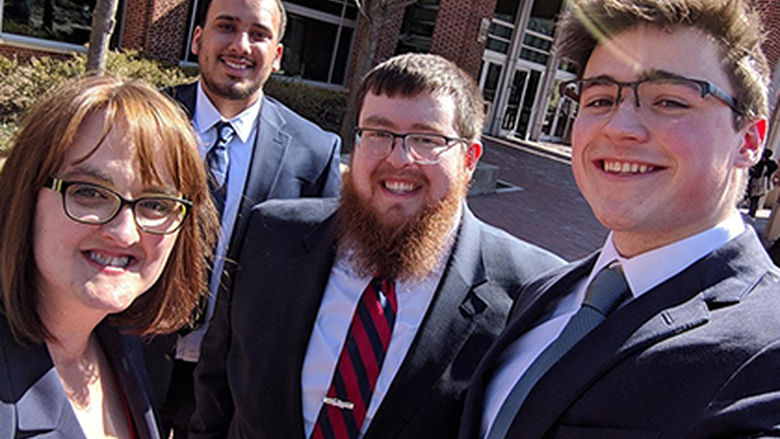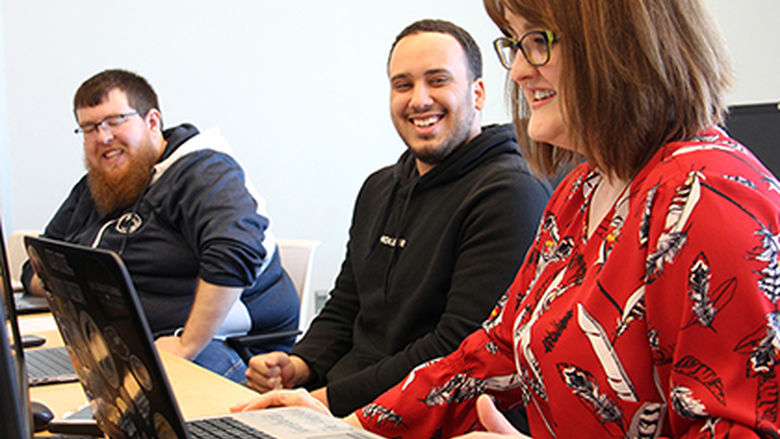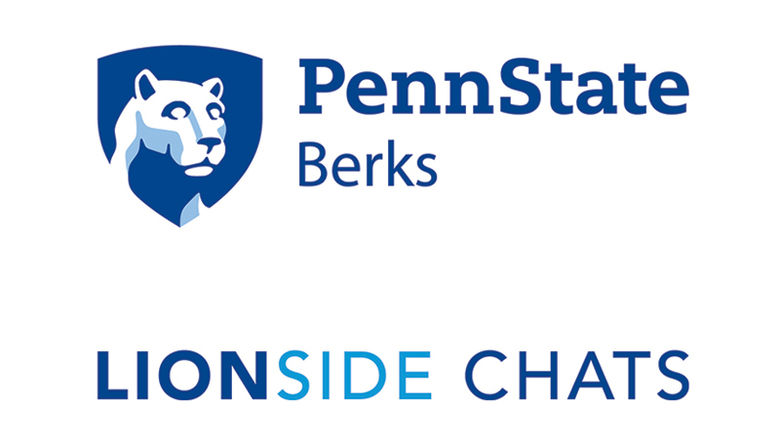
Patrick Scanlon, a senior dual majoring in information sciences and technology and security and risk analysis adjusts to learning remotely for his spring semester classes.
WYOMISSING, Pa. — Since March 16, Alanna Billy of East Earl, Pennsylvania, has started most days sitting at her laptop, taking Penn State Berks courses remotely. The first-year kinesiology major completes all her coursework in the morning and has the afternoon free for studying or spending time with friends and family.
“So far I have made an easy transition into remote learning,” states Billy. “All my professors have been so encouraging: They understand that we all have a lot of worries on our plates right now. I think that Penn State Berks faculty members have strategically taken measures throughout this pandemic and are trying to make things as easy for students as possible.”
When Penn State Berks transitioned to remote teaching on March 16 — along with all the other Penn State campuses — in response to the global coronavirus pandemic, many students and some faculty members had concerns about remote course delivery and losing the personal connections of the classroom. Despite some initial trepidation, faculty members who were novices to remote teaching were up and running with their course delivery within a matter of days of the announcement, thanks to some assistance from fellow professors and staff.
Lending a helping hand
One professor who offered personal assistance to fellow faculty members is Dawn Pfeifer Reitz, lecturer in communication arts and sciences. She explained that she had been thinking about what she needed to do to prepare for remote delivery of her courses before the announcement was made and she was in a good place to manage the transition.
Pfeifer Reitz knew that some of her faculty colleagues, as well as students, were not as comfortable with remote teaching and learning, so she created two blogs with many resources that both professors and students need to succeed. Pfeifer Reitz’s personal blog began with one post to assist faculty in giving online lectures, and morphed into a valuable resource for both faculty and students, with ideas for remote testing, and information to help students become better learners and professors to become better teachers.
After the first week of remote learning, in response to students’ questions and concerns, she created the Penn State Berks Remote Learning blog in collaboration with Sonia Delaquito, coordinator of the Learning Center. It contains articles about time management, motivation, setting boundaries and much more.
Luis Aponte, of Hamburg, Pennsylvania, a first-year student majoring in electrical engineering, was one of many students who had some concerns about remote learning.
“This experience is unlike any other and it hasn't been the easiest for students, parents or professors. My remote learning experience has been quite a change and I've had to adapt but it has been good," he said. "Professors have been very understanding: They understand that these are tough, stressful times for all of us and that we need time to take care of ourselves mentally and emotionally."
He added, “I like using Zoom for classes; an online Zoom class allows me to ask questions in the moment rather than through email.”
Pfeifer Reitz reached out to the college’s academic division heads and offered to assist any faculty members who were struggling with remote teaching. Several accepted her offer.
Carl Mann, an adjunct professor who teaches public speaking, recounted, “Dawn figuratively held my hand through the transition. I’m old school — nothing is electronic in my classroom. Dawn pointed me to a lot of resources on campus — She connected me with Mary Ann Mengel, instructional multimedia designer, who gave me a personal tutoring session on Zoom, and Red [Hongyan Yuan], instructional designer in the Center for Learning and Teaching, who helped me insert a test in Blackboard. The Information Technology department even lent me a laptop.”
“I still prefer teaching in the classroom but I’m functioning,” Mann said, laughing.
Finally, Pfeifer Reitz worked with the Berks Teaching and Learning with Technology group, a faculty learning community that is sponsored by Penn State Teaching and Learning with Technology. The Berks group meets and discusses topics such as innovative instruction technology and how to manage online tests. In addition, faculty members have an opportunity to share success stories with one another.
The college also has two incredible resources that made the transition easier for faculty and students: The Center for Learning and Teaching Technology and the Information Technology department. The center held multiple training sessions for faculty before the transition and these workshops continue. The Information Technology department has ensured that all faculty and students have the resources that they needed to complete the semester.
“The levels of creativity, cooperation, and resilience that I have witnessed over the past month on behalf of our students, faculty and staff have been truly remarkable and attest to the quality of people who serve Penn State Berks and Penn State University.”
— Penn State Berks Chancellor R. Keith Hillkirk
Penn State Berks Chancellor R. Keith Hillkirk expressed pride at the spirit of collaboration on campus. “The levels of creativity, cooperation,and resilience that I have witnessed over the past month on behalf of our students, faculty and staff have been truly remarkable and attest to the quality of people who serve Penn State Berks and the University," he said.
Student success
When Penn State extended remote teaching through the end of the spring semester due to growing federal and state regulations concerning the coronavirus pandemic, most students reported that they were confident in remote learning.
There are many student success stories. Patrick Scanlon, Wyomissing, Pennsylvania, a senior with a dual major in information sciences and technology and security and risk analysis, explained, “Most of our IST assignments are group projects so we've been using various applications for team communication. We use apps like Zoom, Discord, and Microsoft Teams. The professors have been very helpful and accommodating to our needs. Overall [remote learning has] been a positive experience."
Chandler Alenovitz, of New Holland, Pennsylvania, a first-year student majoring in business management and marketing, summarized his experience.
“The transition into remote learning has been nothing but positive for me so far. All my professors are working with me to help me succeed the best way I can. Honestly, I thought it was going to be a rough experience, but everything worked out well," said Alenovitz.
In addition to faculty teaching and remote learning being up to speed, academic support is available to students through both the Writing Center and the Learning Center. Both offer online tutoring by appointment. Students can schedule online appointments with their academic advisers via Zoom. In fact, all the college’s offices and centers are available online and staff members can be contacted via phone or email. For a complete listing of resources for students, visit https://berks.psu.edu/covid-19.
Designing the Future
Marietta Scanlon is one of many faculty members who has converted her dining room into an online classroom, and she hasn’t missed a beat. The assistant teaching professor of engineering and program chair for electro-mechanical engineering technology talked about the engineering design course that she is teaching this semester.
“For my EDSGN 100 class, prior to switching to remote learning, Professor Ed Sauer and I were doing a Learning Factory project with the students for Boeing. Needless to say, that project could not continue," said Scanlon. "We switched gears and the students spent two weeks working through a virtual design project for Boeing instead. The teams presented their designs to a Boeing engineer via Zoom earlier this week.”
For their next project, Scanlon and Sauer’s students will "Hack the Pandemic."
“In class, we have talked about things that have been affected by the pandemic. Their assignment is to individually brainstorm possible problems and solutions," said Scanlon. "Then, in teams, they will continue to brainstorm, as well as design and create a digital prototype of their solutions. We've taken advantage of the Zoom breakout rooms to have team meetings and screen sharing so the students can present their work to the class.”
Many faculty members who use special software in their courses, such as engineering, have worked with the Information Technology Department to make that software available to students remotely. In addition, faculty deliver all courses synchronously, meaning they were held on the same date and time originally scheduled to avoid potential issues for students such as loss of financial aid and time conflicts.
When asked what her hopes were for future remote course delivery, Pfeifer Reitz stated, “I hope this experience opens up awareness to online pedagogy.
“More importantly, it gives us an opportunity to teach students to be resilient and to roll with the punches," she added.
A valuable life lesson indeed.
